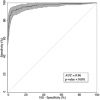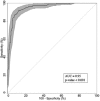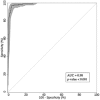Using Artificial Intelligence to Detect COVID-19 and Community-acquired Pneumonia Based on Pulmonary CT: Evaluation of the Diagnostic Accuracy
- PMID: 32191588
- PMCID: PMC7233473
- DOI: 10.1148/radiol.2020200905
Using Artificial Intelligence to Detect COVID-19 and Community-acquired Pneumonia Based on Pulmonary CT: Evaluation of the Diagnostic Accuracy
Abstract
Background Coronavirus disease 2019 (COVID-19) has widely spread all over the world since the beginning of 2020. It is desirable to develop automatic and accurate detection of COVID-19 using chest CT. Purpose To develop a fully automatic framework to detect COVID-19 using chest CT and evaluate its performance. Materials and Methods In this retrospective and multicenter study, a deep learning model, the COVID-19 detection neural network (COVNet), was developed to extract visual features from volumetric chest CT scans for the detection of COVID-19. CT scans of community-acquired pneumonia (CAP) and other non-pneumonia abnormalities were included to test the robustness of the model. The datasets were collected from six hospitals between August 2016 and February 2020. Diagnostic performance was assessed with the area under the receiver operating characteristic curve, sensitivity, and specificity. Results The collected dataset consisted of 4352 chest CT scans from 3322 patients. The average patient age (±standard deviation) was 49 years ± 15, and there were slightly more men than women (1838 vs 1484, respectively; P = .29). The per-scan sensitivity and specificity for detecting COVID-19 in the independent test set was 90% (95% confidence interval [CI]: 83%, 94%; 114 of 127 scans) and 96% (95% CI: 93%, 98%; 294 of 307 scans), respectively, with an area under the receiver operating characteristic curve of 0.96 (P < .001). The per-scan sensitivity and specificity for detecting CAP in the independent test set was 87% (152 of 175 scans) and 92% (239 of 259 scans), respectively, with an area under the receiver operating characteristic curve of 0.95 (95% CI: 0.93, 0.97). Conclusion A deep learning model can accurately detect coronavirus 2019 and differentiate it from community-acquired pneumonia and other lung conditions. © RSNA, 2020 Online supplemental material is available for this article.
Figures










Comment in
-
Coronavirus Disease 2019 Deep Learning Models: Methodologic Considerations.Radiology. 2020 Sep;296(3):E192. doi: 10.1148/radiol.2020201178. Epub 2020 Apr 3. Radiology. 2020. PMID: 32243239 Free PMC article. No abstract available.
References
Publication types
MeSH terms
LinkOut - more resources
Full Text Sources
Other Literature Sources
Medical
Miscellaneous

